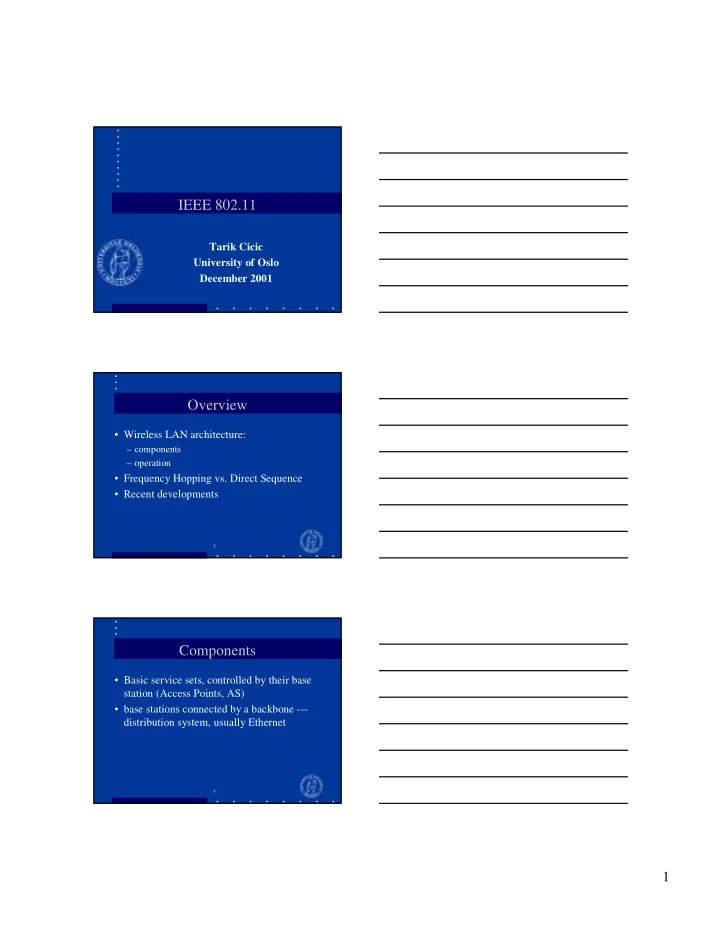

IEEE 802.11 Tarik Cicic University of Oslo December 2001 Overview • Wireless LAN architecture: – components – operation • Frequency Hopping vs. Direct Sequence • Recent developments 2 Components • Basic service sets, controlled by their base station (Access Points, AS) • base stations connected by a backbone --- distribution system, usually Ethernet 3 1
Sample 802.11 LAN Distribution system (Backbone) Extended service set AP1 AP2 BSS1 BSS2 4 IEEE 802.11 layers • Architecture similar to other 802.x technologies • three physical layers supported: – Frequency Hopping Spread Spectrum – Direct Sequence Spread Spectrum – Infra Red • additional functionality in MAC: – fragmentation 802.2 Link Layer – packet retransmission 802.11 MAC – acknowledgments FH DS IR PHY Layer 5 Spread spectrum • IEEE 802.11 uses Spread Spectrum radio transmission: – Frequency hopping (FHSS) – Direct Sequence (DSSS) • diffused infrared transmission is the third physical layer technology 6 2
Frequency hopping • Pseudorandom sequence of frequencies is chosen within a BSS • all communicating parts follow the sequence • 2.4 GHz, 79.1 MHz bandwidth 7 Frequency hopping (2) 2.40 2.41 2.42 2.43 2.44 2.45 2.46 2.47 2.48 GHz Time (fictive frequencies) 8 Direct Sequence 1 Data 0 4-bit 1 random 0 1 Result 0 Data 1010 => 1111000011110000 4-bit random 1011101110111011 Result 0100101101001011 9 3
Direct Sequence (2) • Different senders use different frequencies • dominant technology today: – IEEE 802.11 b – up to 11 Mb/s (~50 m distance) 10 Diffuse infrared ( in IEEE 802.11) • Millimetre (and shorter) waves • Close to the visible light --- cannot pass through walls • but is reflected by walls, no “line of sight” needed • IR can be used on distances of ~10m, while radio transmission can be used ~100m in buildings and 1km outside 11 CSMA/CA • Carrier Sense Multiple Access with Collision Avoidance • sense the medium; transmit if free • collision detection as in wired LAN is not possible: – full duplex needed – no other stations heard means not free medium 12 4
CSMA: hidden nodes • If A and C send in the same time to B, they cannot notice the collision A and C cannot see each other A B C (hidden nodes) 13 CSMA: exposed nodes • B transmits to A. C hears it, but does not transmit to D • this is a mistake, since A cannot hear C and D cannot hear B --- poor resource utilization C is exposed to B’s A B C D transmission 14 Positive Acknowledgment • If the medium is free for DIFS ( Distributed Inter Frame Space ) period, transmit • the receiver checks the CRC and, if OK, sends an ACK 15 5
Collision Avoidance • Virtual Carrier Sense decreases the collision possibility • sender station first sends a Request To Send (RTS), a short packet with source and destination ID and transaction duration • the destination responds with “Clear To Send” • all stations hearing this set their Network Allocation Vector to the given duration • stations delay the sending (+ sense the medium) 16 Collision Avoidance Src RTS DATA SIFS Dest CTS ACK DIFS Other NAV(RTS) Next MPDU NAV(CTS) 17 MAC Functionality 1. Acknowledgments (no ACKs in wired LANs) 2. fragmentation & reassembly: • small packets at radio LANs, 20 ms FH and 2Mb/s give 5242 Bytes • 1518 Bytes in Ethernet 3. exponential backoff procedure used (modified compared to Ethernet) 18 6
Joining a cell (BSS) • Active / passive scanning (beacon message) • the association process (capability exchange) • Roaming through re-association! 19 Security • Authentication through knowledge of a secret key • eavesdropping hindered by use of pseudo random number generator; packets are scrambled with a random sequence 20 Other features • Power save • Ad-hoc networks 21 7
Current Developments • First 802.11 implementations were based on FH, 3 Mb/s communication • IEEE 802.11b standard opens for 11 Mb/s communication using DS • 802.11b is de-facto standard today (despite shorter distances and worsened security) 22 Discussion: Security in 802.11 • Why is WLAN technology often regarded unsecure? 23 8
Recommend
More recommend